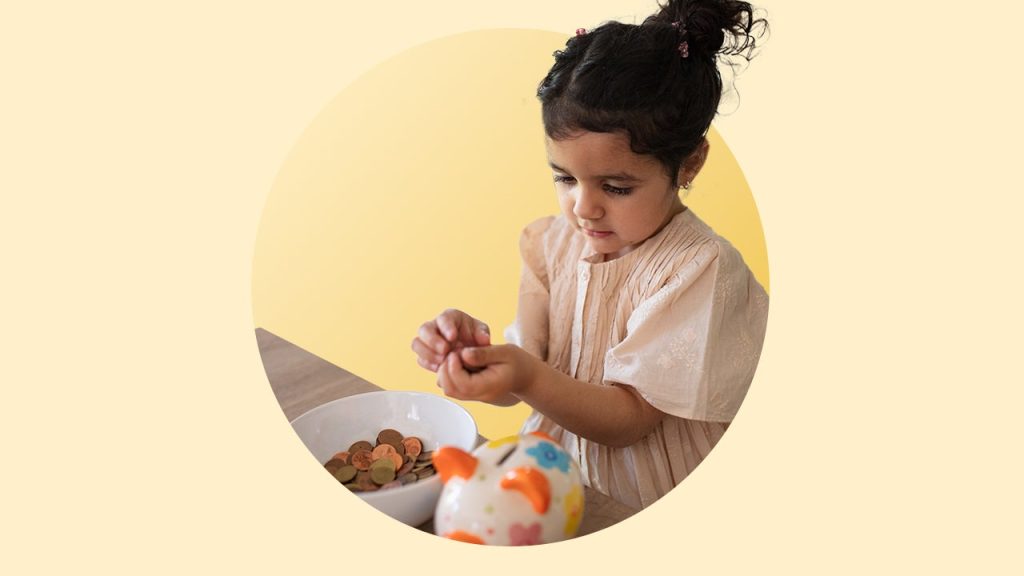Key takeaways
- Kids who learn about investing early in their lives reap multiple benefits, including establishing healthy financial habits that they will use into adulthood.
- Aside from the behavioral benefits that kids receive from having a strong financial education, their money also has more time to compound the earlier they start, potentially setting them up with a safety net as they enter the adult world — or even an early retirement.
- There are several fun, engaging ways to teach your children about finance, from the classic envelope savings method to stock market games and more.
The habits we learn as children often stick with us through adulthood, and so it goes with financial habits, too, according to a recent Bankrate survey. Bankrate’s 2025 Financial Habits Survey revealed that Americans who had a strong financial education as children were more likely to use those habits as adults. Unfortunately, the survey also revealed that more than half of Americans (54 percent) did not receive a strong financial education as children.
“There isn’t much more important than teaching children about finances,” says Steve Azoury, ChFC, owner of Azoury Financial in Troy, Michigan. “When it comes to learning about finances, the schools aren’t teaching it. It’s left to loved ones to teach children valuable lessons on personal finances.”
To set children up for financial success, it can be valuable to teach them about money, including budgeting, credit cards, bank accounts and even more advanced subjects such as investing. Here are seven ways you can teach children about finance and help them succeed.
1. Teach them to save
You need money to invest, and the way for most people to get the cash is by saving it. For many individuals, that means budgeting money, but for others it’s a process of always keeping money in reserve or holding back some of what you earn. This kind of lesson can start early.
“Basic budgeting is easily configured into trips to the store with young children, utilizing the envelope plan or something similar,” says Lori Gross, financial and investment advisor at Outlook Financial Center in Troy, Ohio. “The basis here is that you put aside a specific amount the child has earned through things such as chores, good grades and positive behaviors into an envelope. When you go to the store, they can spend what they have earned, but nothing more. When it’s gone, it’s gone.”
Maintaining this kind of discipline — not overspending — is important because it teaches children to live within their means, even from a young age. They’re forced to prioritize what they want instead of waiting for a parent or relative to buy it for them. The idea of “living below your means” is vital for those who want to build up a sum of money that they can invest later.
2. Open a bank account for their savings
Working with a financial institution is a valuable lesson that can help kids understand how money works.
“Teaching children about personal finances should begin early in life, and it can start with simple lessons,” says Azoury. “This could be something as simple as teaching them to save a percentage of their birthday or holiday cash in a high-yield savings account and then having them watch that savings grow over time.”
Setting up a custodial account for a child at a bank can be an easy step, and many banks offer no-cost accounts for children. As part of the process, it’s an opportune time to teach children the value of interest: Turn to one of the best high-yield savings accounts and show them why this kind of account is more valuable. Then, check in each month on the interest that’s been earned.
3. Encourage them to start a small business
Building a small business can help children understand how money works, too, moving closer to investing. Of course, it’s a better fit for older kids who can handle some responsibility.
Azoury suggests having a child “invest their savings into a product in which they can start a small business and make more money. This could include having them invest in the purchase of a small lawnmower, then work to build their client list and make money cutting grass.”
Even at a small scale, this kind of business connects the idea of work with money and savings. It also allows a child to help make decisions about the business and think about how investing in the business is helping them to make more money.
4. Give stock as a gift
Taking that first step into actually owning a stock or other investment can be managed by giving a share of stock as a gift. You can go about this in a few ways, from simply giving a stock you already own to opening a custodial account for the child and then buying some shares there. One great way to spark a child’s interest is to buy shares in a company that they like or use frequently, helping them connect the (abstract) investment with the concrete business reality.
It can be easy to give the gift of stock and a variety of companies allow you to do so, but you can work with traditional brokers, too.
5. Help them learn about stocks through games
Before you put any serious money on the line, using games could be a great way to teach your child about investing. Classic board games such as Acquire, Modern Art and even Monopoly can teach children how money and investing work in a simplified but still useful way.
If you want to step up to digital experience, you can use stock market simulators and virtual games to teach how investing works more concretely. These simulators give you a bankroll and let you buy and sell stocks, tracking your progress along the way. Children can quickly make the connection that they need to pick the right investments to succeed, and the games help provide exposure to the process of buying and selling investments, making it more familiar.
6. Start an investing account
With a very little bit of money and motivation, you can start a custodial investment account for your child. A child can track the cash in the account and the value of the investments, watch dividend payments come in and even make basic investing decisions with your supervision. Becoming familiar with a brokerage account can make it all feel familiar and normal — exactly what you want.
The best brokerage accounts don’t charge an annual fee and have no minimum account size, so it’s easy to get started. Plus, if you work with one of the best brokers for fractional shares, you can buy even partial shares of stock, so you don’t need enough money for a full share. That means you can literally start with just a few dollars and begin investing.
7. Research a stock or ETF with them
Beyond owning stock and opening an investment account, you can teach your child how to conduct some basic research on a stock, including looking up its stock chart, reading some news about the company and even looking at some basic valuation metrics. While this kind of work is better-suited to older children, it could even be applied in simpler ways for younger ones.
It could also be an opportune moment to explain exchange-traded funds (ETFs), which hold many stocks and may deliver strong returns over time, too. Plus, ETFs are a great way for beginners to invest without having to do all the heavy-duty research as they would for a stock.
Top reasons to teach your kids about investing while they’re children
Most people don’t think much about investing for their children, but there are plenty of reasons why it makes sense to get started early. Aside from getting a jump start on building wealth, there are also many benefits associated with exposure to financial concepts. Bankrate’s 2025 Financial Habits Survey found that Americans who grew up with a strong financial education were more likely to have implemented healthy financial habits and to have successfully negotiated their salaries as adults.
Here are some other top reasons to get your children started with investing.
Develop good saving habits
Habits get ingrained early, so teaching kids about saving and investing while they’re still young can have major benefits for them down the road.
Help them understand that money is earned through work and is needed for necessities such as food and housing. If there’s something they want, consider teaching them about the importance of saving by giving them an allowance that forces them to save up for the item over time.
Learn how to take risks
Children can also learn lessons from the risk involved with investing. Some investments have very low risk but offer returns that are also quite low. Other options, such as stocks, come with higher risk but also have the potential for strong returns. One of the best ways to learn about these differences is by having real money on the line and seeing how your investments perform and how you react to the gains or losses. Kids might get a sense of their risk tolerance, which can help guide them throughout their investing lives.
Compounding returns
One of the biggest benefits of getting kids started with investing is the opportunity to earn compound returns over a very long time horizon. For example, if a child is able to save up $1,000 and invest it when they’re 10 years old, it would be worth about $189,000 when they’re 65 years old or nearly $790,000 when they’re 80 years old, assuming 10 percent annualized returns, about the average return on the S&P 500 index over time. Those numbers should get the attention of even the most rambunctious child.
The table below shows how much a child would have at age 18 or 25 if monthly contributions began at their birth, assuming 10 percent annual returns.
| Monthly Contribution | Balance at age 18 | Balance at age 25 |
|---|---|---|
| $5 | $2,882 | $6,216 |
| $10 | $5,764 | $12,432 |
| $25 | $14,410 | $31,079 |
| $50 | $28,820 | $62,158 |
| $100 | $57,640 | $124,316 |
| $250 | $144,100 | $310,790 |
Note: Assumes contributions were made at the beginning of each month.
More time to recover from losses
Another benefit of investing early is that kids have that much more time to recover from inevitable losses. Depending on the goal they’re investing for, kids will potentially have many decades to invest, giving them plenty of time to gain back any short-term losses that may come due to market selloffs or economic difficulties. Having a long-term mindset is an important part of being a good investor and kids are uniquely positioned to understand this concept. No one’s time horizon is longer than a child’s.
Reach financial security sooner
Getting kids started with investing may also increase the chances that they reach financial security sooner than they would if they started later in life. Compound interest grows over time, so if you have a 10- or 20-year head start on most people, it’s reasonable to think that you’ll get to the finish line faster too. Someone who is an aggressive saver as a child and continues to be one early on in their career will likely be in a strong financial position when it comes time to retire and may even be in a spot to retire early.
FAQs about investing for children
Bottom line
“Teaching children financial responsibility begins at home, and the earlier, the better,” says Gross.
Providing your child a financial education can begin in small ways and advance as the child grows. Give them a little responsibility so that they can see how money works and then slowly increase the scope of the lessons to more complex topics as their mastery and knowledge grow.
— Bankrate’s Brian Baker contributed to a previous version of this article.
Why we ask for feedback
Your feedback helps us improve our content and services. It takes less than a minute to
complete.
Your responses are anonymous and will only be used for improving our website.
Help us improve our content
Read the full article here









